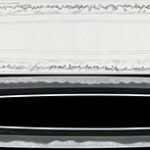Ordering number: 23032
Tachi in Shirasaya(NBTHK the 41st Juyo Token)
Signature: Ichi(judged as Yoshioka Ichimonji)
一(吉岡一文字)
Sayagaki: written by Mr. Tanobe.
Yoshioka Ichimonji from Bizen Province Slightly rubbed up, the first character is
inscribed, and the hole under it, and the body width is normal, and the Koshizori is tall
and dignified.
A mixture of small cyoji midare and smakk gunome midare, which have the texture of
Itame hada with a faint midare utsuri, becomes a straight blade at the grill, and the upper
part of the hatki-omote shows a variety of scenery, which is generally moderate. The
inscription also emphasizes Tsusukedome, etc.
A high ranking shape that clearly shows the characteristics of the same faction.
The nagasa is 2 syaku 4 sunt and 2 bu Tanzan shi(.Diary.)
Koto:Ichimonji:Jyo Jyo saku:Bizen
(We divide 4 sections for each sword as Saijyo saku, Jyojyo saku Jyo saku and regular
saku)
This sword belongs to Saijyo saku ranking.
Habaki: Gold foiled double Habaki
The blade is polished by high ranking sword polisher in Japan.
Blade length:74.8cm or 29.44inches
Sori:3.1cm or 1.22inches
Mekugi:2
Width at the hamachi:3.04cm or 1.19inches
Width at the Kissaki:1.88cm or 0.74inches
Kasane:0.70cm or 0.27inches
The weight of the sword:785grams
Era:
Shape: Almost Ubu Nakago. The Nakago is neatly engraved with a signature „Ichi“. This
signature is reminiscent of Sukeyoshi. The blade is wide and thick with deep Sori, longer
Kissaki. The blade is a magnificent figure.
Jigane: Ko Itame Hada and Mokume Hada well grained. The texture is clearly visible and
Utsuri is well-defined.
Hamon: Ko Nie Deki, bright Choji Midare. The Hamon varies from high to low. The
unique Hamon of Ichimonji.
Special feature: The 2 greatest flows of Bizen swords in the Kamakura period are
Ichimonji school and Osafune school. Ichimonji school prospered in Fukuoka, Yoshioka
and Iwato from the Kamakura period to the Nambokucho period. This school is called
“Ichimonji” because they engrave the character 一”Ichi”(one). There are some patterns of
signature: only “Ichi”, “Ichi” with each swordsmith’s name, and just swordsmith’s name.
Yoshioka Ichimonji school occured right after Fukuoka Ichimonji in the late Kamakura
period. Famous swordsmiths are: Sukemitsu, Sukeshige, and Sukeyoshi. They made not
only similar swords to Fukuoka Ichimonji, but also Gunomemidare works. This Tachi is
quite similar to Fukuoka Ichimonji: small patterns and calm Midareba with Ko-Choji, Ko-
Gunome, and Ko-Notare. There are variety of changes and functionings in Ha, like
Sunagashi and Kinsuji. Ichi character is very clear and it shows strong characteristics of
Yoshioka Ichimonji signature. This had to be preserved very carefully.
From Aoi Art: Nakago is almost Ubu-Nakago. Mei is extremely well-engraved with
condition from those days when it was made. Sori is deep and the shape is typical
Kamakura-period shape. It is very interesting to imagine who owned this sword. We truly
recommend this wonderful Juyo Token.
NBTHK the 41st Juyo Token
Aoi Art estimation paper: whole Oshigata by Ayaka Tsuruta
Order Form
Related Items:
 Wakizashi: Mumei (Yoshioka Ichimonji)
Wakizashi: Mumei (Yoshioka Ichimonji)
 Dai Sho:Tsushima Kami Tachibana Nyudo Tsunemitsu
Dai Sho:Tsushima Kami Tachibana Nyudo Tsunemitsu
 Wakizashi: Bizen Koku Ju Osafune Tadamitsu (60th NBTHK Juyo Token)
Wakizashi: Bizen Koku Ju Osafune Tadamitsu (60th NBTHK Juyo Token)
 Katana: Hizen Kuni Kawachi Daijo Masahiro (first generation)(61st NBTHK Juyo Paper)
Katana: Hizen Kuni Kawachi Daijo Masahiro (first generation)(61st NBTHK Juyo Paper)
 Katana:Mumei (Ayakoji)(49th Juyo Token) (Consignment Sale)
Katana:Mumei (Ayakoji)(49th Juyo Token) (Consignment Sale)
 Katana:Mumei (Nobukuni)(Juyo Token 30th session)(Koshirae:NBTHK Hozon Tosogu)
Katana:Mumei (Nobukuni)(Juyo Token 30th session)(Koshirae:NBTHK Hozon Tosogu)






